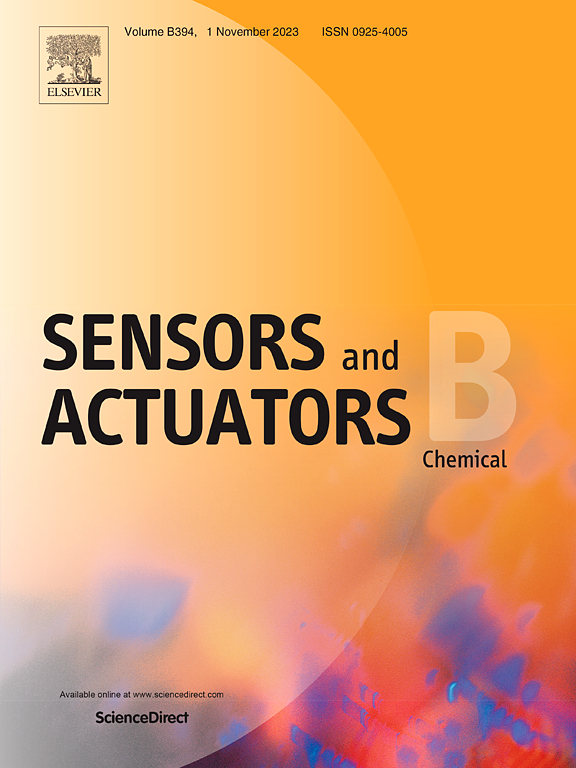IF 8
1区 化学
Q1 CHEMISTRY, ANALYTICAL
引用次数: 0
摘要
亚波长介质光栅波导结构可通过产生导模共振(GMR)实现高质量系数(Q-factor)共振峰/骤降,从而实现高分辨率生物传感。然而,传统设计需要在实现高 Q 因子和高灵敏度之间做出权衡。为了克服这一限制,本文提出了一种新型反射型 GMR 元表面,它将二次光栅阵列与金属反射器集成在一起。与传统的透射型单层光栅结构不同,我们的设计采用了位于基底和波导之间的金属反射器,从而将局部电磁场限制在波导内,并防止其泄漏到基底中。同时,次级光栅实现了分析物与局部电场之间的大空间重叠。因此,在横向电(TE)极化法线入射条件下,我们的元表面表现出明显的共振倾角和较窄的线宽,从而大大提高了生化传感灵敏度和 Q 值因子。此外,所提出的元表面的测量灵敏度为 420.33 nm/RIU,可特异性检测与胃癌细胞相关的生物标志物细胞角蛋白 8 和 18 (CK8/18)。与传统的 GMR 传感器设计相比,我们的方法不仅具有优异的传感性能,而且由于其低纵横比光栅结构而具有实用的制造优势。因此,这种首次提出的反射型 GMR 二次光栅结构为高灵敏度、高 Q 因子元表面的开发提供了一条前景广阔的途径,可用于临床诊断中的高精度、高分辨率、高信噪比传感应用。本文章由计算机程序翻译,如有差异,请以英文原文为准。
High-sensitivity biosensors based on reflection-type guided-mode-resonance secondary grating metasurfaces
Subwavelength dielectric grating waveguide structures can achieve high-quality factor (Q-factor) resonance peaks/dips through the generation of guided-mode resonance (GMR), which enables high-resolution biosensing. However, conventional designs face a trade-off between achieving high Q-factor and high sensitivity. To overcome this limitation, this paper proposes a novel reflection-type GMR metasurface that integrates a secondary grating array with a metallic reflector. Unlike traditional transmission-type monolayer grating structures, our design employs a metal reflector positioned between the substrate and the waveguide, which confines the localized electromagnetic fields within the waveguide and prevents their leakage into the substrate. Simultaneously, the secondary grating achieves large spatial overlap between the analyte and the localized electric fields. As a result, under transverse electric (TE)-polarized normal incidence, our metasurface exhibits a pronounced resonance dip with a narrow linewidth, leading to significantly high biochemical sensing sensitivity and high Q-factor. Furthermore, the proposed metasurface demonstrates a measured sensitivity of 420.33 nm/RIU and a specific detection of the biomarker cytokeratin 8 and 18 (CK8/18) associated with gastric cancer cells. Compared with conventional GMR sensor designs, our approach offers not only superior sensing performance but also practical fabrication advantages due to its low aspect ratio grating structure. Therefore, this first proposed reflection-type GMR secondary grating structure provides a promising pathway for the development of high-sensitivity, high Q-factor metasurfaces, with high-precision, high-resolution, high signal-to-noise ratio sensing applications in clinical diagnostics.
求助全文
通过发布文献求助,成功后即可免费获取论文全文。
去求助
来源期刊

Sensors and Actuators B: Chemical
工程技术-电化学
CiteScore
14.60
自引率
11.90%
发文量
1776
审稿时长
3.2 months
期刊介绍:
Sensors & Actuators, B: Chemical is an international journal focused on the research and development of chemical transducers. It covers chemical sensors and biosensors, chemical actuators, and analytical microsystems. The journal is interdisciplinary, aiming to publish original works showcasing substantial advancements beyond the current state of the art in these fields, with practical applicability to solving meaningful analytical problems. Review articles are accepted by invitation from an Editor of the journal.
 求助内容:
求助内容: 应助结果提醒方式:
应助结果提醒方式:


